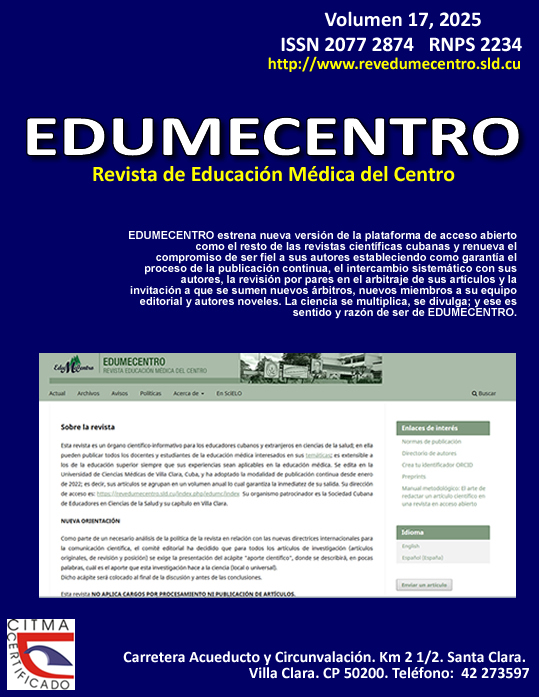Obstetric violence perceived by Obstetrics students. San Marcos Mayor National University. Lima-Peru
Keywords:
patient safety, internship and residency, inservice training, patient care, job description, staff development, education, medicalAbstract
Background: obstetric violence may be perceived by health professionals as a poor treat and not as violent acts because of a deficient knowledge of this variable.
Objective: to analyze the perception on obstetric violence among Obstetrics students from a state university in Lima-Peru.
Methods: a descriptive, correlational and cross-sectional study with a quantitative approach and a non-experimental design was carried out. Analysis-synthesis and induction-deduction were used as theoretical methods and PercOV-S questionnaire as an empirical one and as an analysis instrument; it consisted of 33 items grouped in two dimensions: protocolized-visible and non-protocolized-invisible.
Results: obstetrics students have a greater perception on obstetric violence in the protocolized or visible dimension (mean 3.82 ± 0.988) compared to the non-protocolized or invisible dimension (mean 3.03 ± 0.810). The student's gender was the only characteristic that was significantly associated with the perception of obstetric violence, both in the global score and in its dimensions (p<0.01).
Conclusions: the perception on obstetric violence among Obstetrics students from a state university in Lima-Peru was analyzed; it was found that they have a higher global perception than the average regarding obstetric violence, especially among female students.
Downloads
References
1. Yalley AA, Abioye D, Appiah CY, Hoeffler A. Abuse and humiliation in the delivery room: Prevalence and associated factors of obstetric violence in Ghana. Frontiers in Public Health [Internet]. 2023 [citado 12/01/2025];11:988961. Disponible en: https://doi.org/10.3389/fpubh.2023.988961
2. Martínez JM, Rodríguez J, Rubio A, Ortiz I, Ballesta A, Hernández A. Obstetric Violence from a Midwife Perspective. International J of Environmental Research and Public Health [Internet]. 2023 [citado 12/01/2025];20(6):4930. Disponible en: https://doi.org/10.3390/ijerph20064930
3. Martínez JM, Martínez S, Rodríguez J, Hernández A. The magnitude of the problem of obstetric violence and its associated factors: A cross-sectional study. Women and birth: J of the Australian College of Midwives [Internet]. 2021 [citado 10/01/2025];34(5):e526–e536. Disponible en: https://doi.org/10.1016/j.wombi.2020.10.002
4. Terribile DC, Sartorao CI. Perceptions of the Brazilian obstetrics physicians about the term obstetric violence: a cross-sectional study. Rev da Associacao Medica Brasileira [Internet]. 2023 [citado 10/01/2025];69(2):252–256. Disponible en: https://doi.org/10.1590/1806-9282.20220945
5. Gray T, Mohan S, Lindow S, Pandey U, Farrell T. Obstetric violence: Comparing medical student perceptions in India and the UK. European J of Obstetrics, Gynecology, and Reproductive Biology [Internet]. 2021[citado 11/01/2025];261:98–102. Disponible en: https://doi.org/10.1016/j.ejogrb.2021.04.013
6. Martins-Loreto TM, Kuhn Dos Santos JF, Nomura RMY. Understanding the opinion of doctors on obstetric violence in Brazil to improve women's care. Midwifery [Internet]. 2022 [citado 12/01/2025];109:103294. Disponible en: https://doi.org/10.1016/j.midw.2022.103294
7. Goaz S, Feldman N, Padoa A. [Obstetric violence - since when and where to: implications and preventive strategies]. Harefuah [Internet]. 2022 [citado 15/01/2025];161(9):556–561. Disponible en: https://pubmed.ncbi.nlm.nih.gov/36168158/
8. Mena-Tudela D, Cervera A, Alemany MJ, Andreu L, González VM. Design and Validation of the PercOV-S Questionnaire for Measuring Perceived Obstetric Violence in Nursing, Midwifery and Medical Students. International J of Environmental Research and Public Health [Internet]. 2020 [citado 12/01/2025];17(21):8022. Disponible en: https://doi.org/10.3390/ijerph17218022
9. Huarino SL, Choque O. Violencia obstétrica en mujeres atendidas en un hospital público. Rev Médica Basadrina [Internet]. 2021 [citado 12/01/2025];15(3):3–10. Disponible en: https://doi.org/10.33326/26176068.2021.3.1151
10. Moreno ZR. Percepción de violencia obstétrica en pacientes atendidas en un Hospital Docente de Lima Perú. 2018. Rev Internacional de Salud Materno Fetal [Internet]. 2019 [citado 12/01/2025];4:S14-S14. Disponible en: http://ojs.revistamaternofetal.com/index.php/RISMF/article/view/125
11. Biurrun-Garrido A, Brigidi S, Mena-Tudela D. Percepción de estudiantes de ciencias de la salud sobre la violencia obstétrica. Enfermería Clínica [Internet]. 2023 [citado 14/01/2025];33(3):234-243. Disponible en: https://doi.org/10.1016/j.enfcli.2023.02.005
12. Mena D, Cervera A, Andreu L, Alemany MJ, Valero MJ, Peris E, González VM. Perception of obstetric violence in a sample of Spanish health sciences students: A cross-sectional study. Nurse Education Today [Internet]. 2022 [citado 12/01/2025];110:105266. Disponible en: https://doi-org.unmsm.lookproxy.com/10.1016/j.nedt.2022.105266
13. Cohem S.Korem K. Domesticating bodies: the role of shame in obstetric violence. Hypatia [Internet]. 2018 [citado 12/01/2025];33(3):384-401. Disponible en: https://doi.org/10.1111/hypa.12428
14. Scandurra C, Zapparella R, Policastro M, Continisio GI, Ammendola A, Bochicchio V, Maldonato NM, Locci M. Obstetric violence in a group of Italian women: socio-demographic predictors and effects on mental health. Culture, health & sexuality [Internet]. 2022 [citado 12/01/2025];24(11):1466–80. Disponible en: https://doi.org/10.1080/13691058.2021.1970812
15. Mena D, González VM, Soriano FJ, Bonanad T, Centeno L, Vila R, Gasch ÁC. Changes in health sciences students' perception of obstetric violence after an educational intervention. Nurse Education Today [Internet]. 2020 [citado 12/01/2025];88:104364. Disponible en: https://doi.org/10.1016/j.nedt.2020.104364
Published
How to Cite
Issue
Section
License
Los autores que publican en esta revista están de acuerdo con los siguientes términos:- Los autores/as conservarán sus derechos de autor y ceden a la revista el derecho de primera publicación de su obra, el cuál estará simultáneamente sujeto a una Licencia Creative Commons Reconocimiento-NoComercial-CompartirIgual 4.0 Internacional (CC BY-NC-SA 4.0) que permite a terceros compartir la obra siempre que se indique su autor y su primera publicación esta revista.
- Los autores pueden establecer por separado acuerdos adicionales para la distribución no exclusiva de la versión de la obra publicada en la revista (por ejemplo, situarlo en un repositorio institucional o publicarlo en un libro), con un reconocimiento de su publicación inicial en esta revista.
- Se permite y se anima a los autores a difundir sus trabajos electrónicamente (por ejemplo, en repositorios institucionales o en su propio sitio web) antes y durante el proceso de envío, ya que puede dar lugar a intercambios productivos, así como a una citación más temprana y mayor de los trabajos publicados (Véase The Effect of Open Access) (en inglés).










